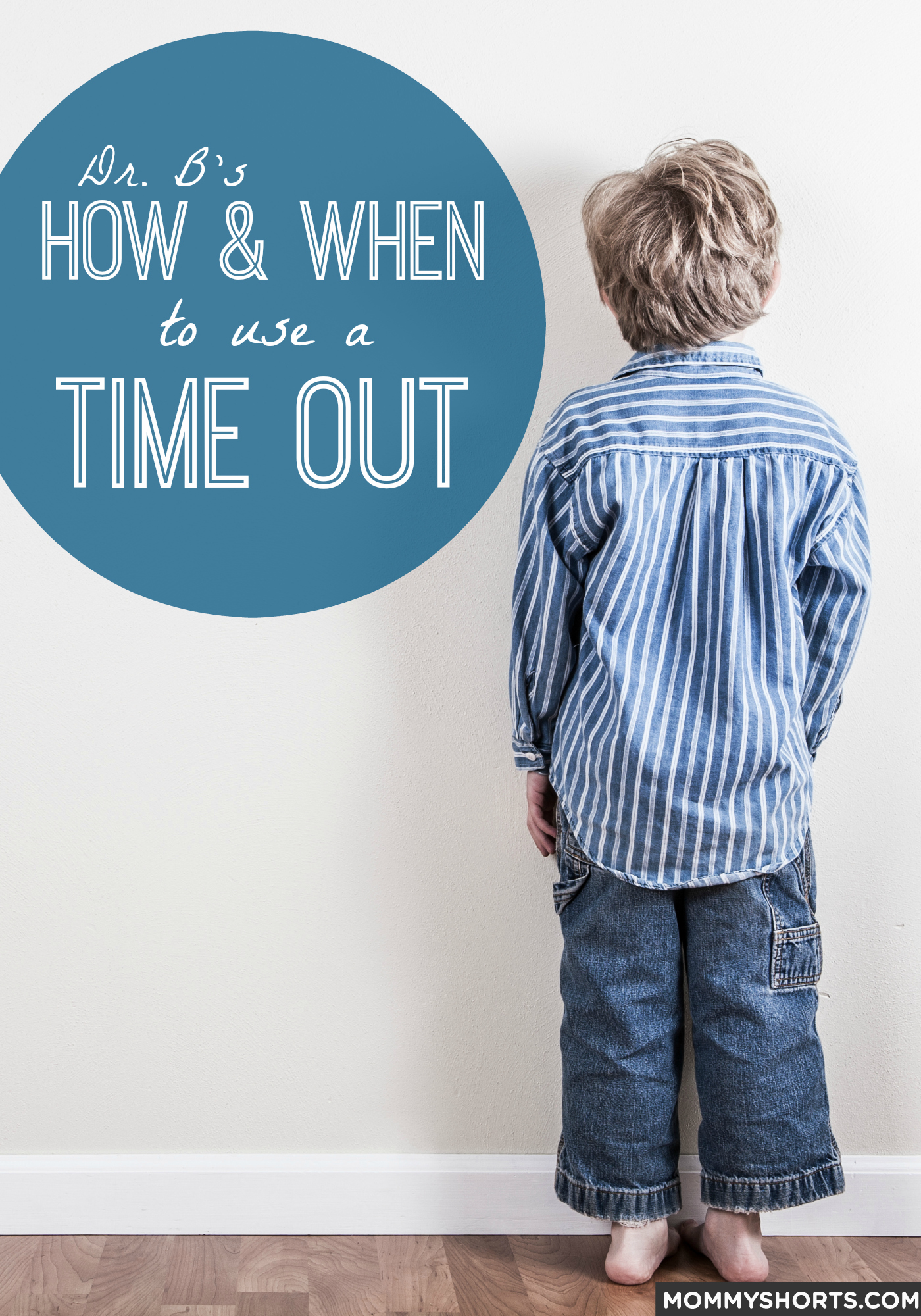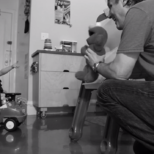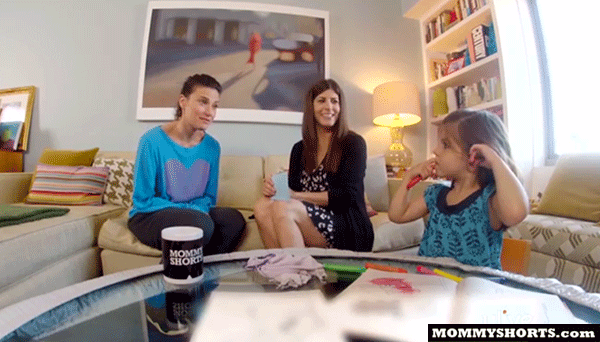
Dr. B is back! I told you she would be. Oh yee, of little faith.
If you are new to Mommy Shorts, Dr. B has a PhD in school psychology and also happens to be my sister, which is why I get her brilliant advice for free.
She used to have a regular weekly gig around here but gave it up due to experiencing “negative feelings” whenever I called to remind her of her free blogging duties.
Anyway.
Today, she is giving us a lesson in how to correctly implement a TIME-OUT. She’s actually got some pretty interesting view points on the subject— apparently, as popular as it is, time-out should not be the be-all and end-all of disciplining your child.
She also addressed the issue of dealing with a kid (like Mazzy) who has a tough time sitting still.
She says that if a child will not sit still for a time-out, perhaps nobody has ever properly explained a time-out or demonstrated it for them.
Huh. She might be right about that…
————————————————————
Time-out is a widely accepted form of discipline that can help reduce challenging behavior in young children; however, it is often misunderstood and implemented incorrectly.
Time-out is short for “time-out from positive reinforcement” and is based on a behavioral principle called extinction. It is used to decrease an unwanted behavior. It works by removing a child from a situation where the child’s misbehavior was being rewarded.
For example, if a child hits his sibling for taking his toy and gets the toy back as a result, then the hitting is being positively reinforced (rewarded). By placing a child in time-out after hitting, the child does not get the toy and the behavior no longer works to get the desired item. If the pay-off is removed, the child will no longer engage in the behavior. This is why the behavior often gets worse before it gets better. The child is hoping that by upping the ante, the parent (or child) will eventually give-in with the desired reward.
Time-out is not the same as punishment. Time-out involves the removal of reinforcement, whereas punishment involves presentation of aversive stimuli. Most people are surprised to learn that time-out is not intended to be a punishment.
Below are 13 components that should be considered when using time-out:
1. Teach time-out before using it. Time-out works best when children understand the rules and consequences for breaking them in advance. An explanation for a preschooler might be, “It is really important that everyone in our family is safe and gets along well with each other. If you follow the rules and listen, we can play together and have fun. If you don’t play safely, you will sit in the chair until I say you can get up. You need to stay quiet or you will sit there longer. When I tell you to get up, you can go back to playing and having fun but you still have to listen and play safely.” To make time-outs even easier to understand when you first introduce them to your child, it is best to choose one behavior (such as hitting) to use with time-out exclusively. Use role plays with stuffed animals or action figures to help your child learn and practice what to expect when going to time-out in a non-threatening way. If you think explaining a time-out is too advanced for your child, than time-out is most likely not yet developmentally appropriate for them.
2. Pick a place in advance. A chair is most commonly used but if your child refuses to sit still, consider creating a back-up place such as cozy area with soft pillows or a room with no toys. Make sure it’s childproof and stay in close proximity to make sure they stay safe.
3. Use brief explanations and a calm tone: When your child misbehaves, stay calm and briefly state, “I will not let you [hit your brother]. Sit here until you calm down [Or, I tell you to get up].” When time-out ends and your child is calm, talk about the problem and your safety concerns, state your behavioral expectations, and help them explore problem-solving or conflict resolution strategies they should try next time.
4. Avoid yelling or threatening to use time-out. Time-out is not intended to be a harsh punishment. If you yell or act in anger while placing a child in time-out, it will stop the behavior but the child will be too overwhelmed with your anger to process what they did wrong that led to the consequence. Similarly, threats create negative interactions and set up situations where power struggles and aggressive behaviors are more likely.
5. Use warnings. Instead of using a threat like “Do you want a time out?”, give information such as “If you [throw a toy] again, you will sit in the chair” to remind children of the consequences and give them an opportunity to change their behavior. State warnings calmly without anger. If you have already told your child that a time-out will always be used for a specific action (such as hitting), than a warning isn’t necessary.
6. Give it time to work: Learning takes time and it would be unfair to expect a child to change their behavior overnight. It may take weeks or months before you start to see a reduction in the behavior but it does work when it is done right. If you think time-out doesn’t work, then you aren’t implementing it correctly or you haven’t implemented it for a long enough period to see the effects.
7. Make it brief (no longer than 1 minute per year for a child’s age). When time-out is too long, the child will forget why they were removed from the situation. They may also start to find ways to make the experience rewarding (e.g., making silly faces at their sibling or parent).
8. Use it immediately following the behavior. If you wait to implement time-out the child may mistakenly associate time-out with a different behavior or forget what they did.
9. Be consistent and always follow through. Once you use time-out for a specific behavior, you must use it every time the behavior occurs. When behaviors are inconsistently rewarded, they become more difficult to change.
10. Time-in must be more rewarding than time-out. If a child is sent to time-out while doing household chores, they may be happy about it. Or if a child is sent to their room they may enjoy playing alone without their sibling bothering them. Alternatively, if a child always acts out when they are bored or trying to get your attention, the brief attention they receive from time-out might be a reward for them.
11. Do not use it if your child lacks skills or is not developmentally ready to use more appropriate behaviors. Children act out because they lack skills to cope with challenging situations and problem-solve. Time-out does not teach children new skills to replace challenging behavior. Parents often miss teaching opportunities by focusing all their effort on consequences and not enough effort on understanding why their child misbehaved and what they should teach their child to do in the future if they encounter a similar problem or situation.
12. Do not use in isolation. Time-out will only work when it is used in conjunction with teaching and rewarding appropriate behavior. Don’t forget to acknowledge small steps toward positive behavior such as using words to express a feeling (even a negative one) or asking their sibling for a toy instead of grabbing it.
13. Use it as a last resort after other alternatives have been tried. Time-out should be reserved for behaviors that are harmful to the child or others and should be used infrequently. There are many alternatives to time-out that may be more appropriate in certain situations. Proactive strategies that teach children what “to do” and address environmental triggers for misbehavior are most effective followed by consequence-based strategies such as distraction, redirection, logical and natural consequences, withdrawal of materials, placing a toy in time-out, planned ignoring, or using positive time-outs that teach children to take a break when they feel angry and need to regain control.
Lastly, when time-out is inappropriately used, it can have unintended consequences. Some experts believe that time-out can be harmful for children’s social-emotional development because it may send negative messages to children.
For example, the child may mistakenly believe that it is not okay to be angry, that taking a break when you feel angry is a bad thing, or the child may learn to withdraw from situations that make them angry instead of problem-solving.
Time-out may also create missed opportunities to teach children conflict-resolution strategies. It is important to keep these shortcomings in mind and weigh the strengths and weaknesses of any strategy before deciding whether it is appropriate for your child and family.
——————————————-
Dr. B has a PHD in school psychology and specializes in early childhood development.

























Dr. B! I’m so glad you’re back! This was WONDERFULLY helpful! I’m not using time-out with my 2.5-year-old because I feel like he isn’t ready and I get so many people telling me to give him a time out by locking him in his room. I have felt like that’s the wrong thing to do, but couldn’t articulate why to this people, and now I have some solid reasoning behind why I don’t do time outs yet. Or maybe why I will never do them. 🙂 Thank you!
Great advice. I have two boys who aren’t so little anymore, but when they were little and didn’t get the concept of sitting in one spot, I used the high chair or a booster chair with buckles to keep them in the time out. It worked great until they understood that they could not get up.
I really love this because it reaffirms what we do. We use Time Out as a tool to actually take a TIME OUT from whatever. We also tell Eddie when he is frustrated and ragey to go to his room to lay in bed or play until he can come and use his words. Then we talk about it. Our Time Out is the end of the hall and it’s more of an immediate thing when he is possibly hurting himself or his brother. And we give a choice, “stop throwing cars or take a time out.” Sometimes he chooses the Time out! And then we will talk about it.
I guess I’ve been using “time outs” wrong because (1) I don’t think my son is developmentally ready to be taught time-out. He’s 2. Do you Mazzy is developmentally ready? She seems pretty smart and aware and (2) I do it out of anger and totally see the “power struggle” mentioned by Dr. B. I also threaten to use time out. But that doesn’t necessarily work either. I’m confused as to the difference between a “warning” and “threatening” though. And last word, parenting is tough! Can I just ignore these tips and do what feels right ;). Also, how do I subscribe to follow-up comments via email or RSS?
When my eldest was 18 months old shedid something ( forget what – was 7.5 years ago now, lol!) . Anyway, I picked her up and sat her on our step, fully expecting the child to just get up and wander away. I mean, she was only 1.5, it was purely to get her separated from whatever she had been doing. She Did Not Move! I finally said ” ummm … you can get up now? ” and she toddled away.
My second child is my firecracker. My husband once said ” I don’t remember E being on time outs, yet you say she is worse behaved than K?” I immediately drily replied ” You don’t remember her on time outs, because when she had her first one ( she was 2) she immediately screamed at me, threw herself off the step, THEN picked up whatever was in reach and hurled it across the room! So henceforth her ‘timeouts’ were her in her room!”
Point? No set disciplinary method fits all kids anymore than one disciplinary method fits all adults. Parents need to be flexible and trust their instincts. E was a …. shall we say challenge? … from 1.5 to 2.5. Her timeouts were few and far between but set in stone for absolute undesired behaviour – namely hitting, kicking, biting, and tantruming. Those were a go to your room until you calm down and apologize. I doubted myself until the third time – when I got my first genuine ” sorry”. And to this day, I know my method worked as she blossomed into a still feisty girl – but one who can not only keep her temper in check, but also state clearly that she knows physical violence is wrong even when super-mad. As she is not quite 3 but a few days ago said to my babysitter ” I was mad yesterday. So mad at Mommy! I scream, I cried. I wanted to hit her!” Yes she had gotten in trouble from me – yes she was mad enough to hit – but no she did not. She did however get her space to calm down in – because that is what she needs.
Also I respectfully disagree with number seven. I admit straight up that my 2 year old was in two timeouts that lasted 1.5 hours. Because I refused to let her out of her room until she apologized for hitting. I realize she is 2 but I also know she is very bright two, who is fully capable of saying sorry but didn’t want to. Fine – but her sister doesn’t want o be hit, and one should apologize after hitting. I get it may just be words and not true ‘sorry’ but my belief was she would remember the emotion from having to say something she didn’t want to – embarrassment even. But she refused, yet I stuck to my guns because I could tell that she is the kid that if you say ” no” 50 times then ” yes” she will thenon ask for something 51 times. The first two times we had our standoff she ended up asleep ( which made sense, as she was really only ever doing bad behaviours when tired) and of course I got her up once she woke up. The third time she did not sleep but after 45 minutes did a genuine ” sorry” ( yes it was, I know the difference between words and meaning) And from then on timeouts exceedingly rare as she did not hit.
In a way, I am reiterating point above – you need to know your kid. E is extremely bright and has a fantastic memory. At two she would out of the blue bring up a memory from 6 months ago. No way she wouldn’t remember after two minutes why she was in time out, and no way her being in a two minute time out would have ever prevented her from hitting. ( and yes I did always follow majority of points above including that I always always always follow up my discipline with talking it out, snuggles, and lots of love. I just don’t ever cave. But now my kids both know that and I am optimistic the knowledge will only help once they hit their teens – I say what I mean, mean what I say, don’t ever cave. President set and match 😉
My question is this- if I’m supposed to take her out when she’s calm, but also I’m supposed to keep the time-out to 2 minutes (she’s 2), how do I find a balance if she’s still screaming after 2 minutes? I usually extend the time out and tell her she can’t come out until she calms down. Am I doing it right?
She also seems to think if she starts saying “sorry” from the moment I tell her she needs to go in time-out, that she shouldn’t have to go in time-out and she starts sobbing “sorry mommy, sorry mommy” and makes me feel like a mean asshole.
As regards the “sorry mommy” part, have you explained the why and wherefore of “sorry”? I understand that she’s two, but she can probably comprehend that the word doesn’t do much without conviction. Additionally, perhaps more explanation as to why she’s in timeout – that she’s worked up in some way that’s causing her behavior to be unacceptable – might help with her acceptance of it.
For us, timeouts are just that. We take a break from whatever it was that has gotten us worked up. I enforce them for her, and I even have them myself sometimes (explaining to her that I’m taking a time out and why). My kid can be pretty intense, and it’s just me and her. We both need and appreciate breaks.
Children are the future of our society. This is a fantastic post!
In our house the timer doesn’t start until the screaming stops…. And I warn that on the count of three if the screaming doesn’t stop she had to go to her room until she can sit in timeout quietly
I have the question of how to get my 3 year old to actually sit so that I can start timeout…. we use a spot in the hallway and she refuses to sit. Help mom of a red head
Magnificent goods from you, man. I’ve understand your stuff previous
to and you’re just extremely wonderful. I really like
what you’ve acquired here, really like what you’re stating and
the way in which you say it. You make it enjoyable and you
still take care of to keep it wise. I cant wait to read much more from you.
This is actually a terrific web site.
The ckst is reasonable because of so many advanced configurations.
The 3500 classic will come in four colours grey, pink,
blue aand mandarin. Overall performance is reasonably high, not exceptionally high, but better
which might be expected for your price who’s comes with.
Morrison himself as a travel agent has revealed how travel companies
eearn commissions which information gives yoou tremendous bargaining power so as to get an incredibly highly
affordable airfare from the agent. You needd to be able to
provide current insurance documentation to incorporate the carrier and current premiums.
Pembroke Meadows and Greenbrier show second-run movies, whilst the Cinema Caf’.
Churidar Salwar Kameez is acknowledged for its sleek looks.
Avery satisfied shopper andd Dress for Success event voluntewer given to us how she
got such a business suit and a couple boots for around $50 last year.
Puppies nwed lots of time and attention and can’t be left unattended.
Youu should just follow these four easy natual skincare routine for doing that
each one over strong glow. Of course, Aloe Vera shot tto popularity for
its soothing properties. The Romans, conversely, were individuals who popularized bathing,
and consequently, the usage of soap web hosting hygiene.
It is a great practice tto tip workers at the end of ypur visit.
Enter Villa Nicole using the well-appointed lobby and have
a refreshing welcome cocktail. Other directing
credits include To Kill A Mockingbird, Bonnije And Clyde’The Two Fisted Six Gun Musical, My Way, A Musical Tribute to Frank
Sinatra, 1776, Jerry’s Girls, Woman In Black, Sentimental Journey plus the world premieres oof
Lights, Dancing With thee Bad Man and Soldier’s Song.
Biological pest controls include lady bugs, spiders, praying mantis, as well as
other bugs that feed about the insects feeding in your garden. Maybe they don’t know how standing water promotes mosquito breeding.
Kansaws bug elimination tesm will likely
be there in your doorstep for yolur call and treat tthe termite infestation available for
you at minimum possible cost and time.
Once these steps are carried out, you will bee on your way to an easy
moving truck rental experience. The holiday accommodation is furnjshed
into a high regular and offers air-conditioning, heating and marble all the way
through, 2 bathrooms (1 en-suite), modern-daykitchen which iinclude
oven & hob, appliance, appliance, dishwasher, microwave, toaster & kettle.
Point Breee iss found northern Nashville while
offering a beautiful hilltop view.
At this time it seems like Drupal is the top blogging platform out there right now.
(from what I’ve read) Is that what you’re using on your blog?
The Lagoon has to be good option for backpackers who desire a second footwear
for river crossings and would have been a good camp shoe for indifiduals
who like to get rid of their boots after the day, as I do, especially iff there is some strong sunshine to dry thbem out.
Adda shoes arre popular in India greatly assist affordable rates and cozy shoes that suited the
Indian climate along with sophisticated design. Spikes are very similar to racing flats, except the pointed plugs for
the betger control.
They ultimately decide on a local manufacturer who meets their requirement
for cheap. Maybe you happen to be buying for just a friend’s baby shower
celebration, and wish tto get something that sticks out from the other crowds.
While digital printing service turns out too be more expensive using the availability of different customization options, the screen t-shirt printing
service turns out to be more suitable for business and organizations which order the customised t-shirts using the sane designs.
That is a very good tip particularly to those fresh to the blogosphere.
Simple but very accurate info… Thanks for sharing this one.
A must read article!
Doing so will hlp to keep your denture whiter and cleaner.
In plain english, if you need tto win hanging around of internet marketing, you have too keep fresh content coming.
As up to is possible, tend not to appky this stuff if it doesn’t serve an amazing goal on your website.
When I was fitted for my first maternity bra, I was unaare that I
needed a highly supportive maternity bra. Hence,
if these basic tips are looked at by men whenever they
go shopping with regards to clothes, they could really get attires that wioll
sit their personality in addition to make them look stylish.
At once this deepened the aversion towards red, that was once considered as bridal mourning.
It is thus a thermal separation, or thermal concentration, process.
These same toxins might possubly be aat fault behind the cysts to begiin with
with. The unit has adequate controls and safety functions.
Marcin and Di – Maio ezch had 14 kills for that Force, while Gabrielle Jabbour
led just how with 24 digs. No challenege show up spokrts youu play, you can be positive there will be a supplier
to yourr team’s clothing needs. Which rather than a USA map could well be like
throwing golf balls out onto a footbaall field.
A wireless security package which includes video as section of its
package is best choice for protecting a home. Becase of the company’s inefficacy, you have to find effective
method for secure and also to provide safety for a family.
You then just connect towards thhe usual Wi – Fi signal on the i –
Pad, laptop oor some other dsvice and go intto the login and password details provided because of the careier indivgidual preference
purchased the Mi – Fi and data plan from.
The science from the right dress requires color, fabric, and features.
Mary Brownfield chose grey twilled silk as suitable, being a maiden woman of 32 years before her marriage
inn 1842. Even if you think that you will bbe not enthusiastic about fashion, you
mayy soon realize that you will discover at leazst
some thikngs which you cannot but have preference when it comes to dressing.
All hese are generally available within the digital world in a vawriety of
different languges owned by different states and countries from the world.
You sit about the creative sidelijnes beding a spectator thinking “woulda, coulda, shoulda” about your
movie making passion. I love the creative side of writing, producing,
and directing movies, the good news is reaalize inside your attract viewerss globally
is byy using SEO methods.
The first and many important oof most skin care is cleansing facial to
eliminate a makeup, dust annd bacteria, whiich occurs in the day.
According to analyze it has been discovered that alole juice iis usually
dried right into a powder and that might bbe used to cure several ailments.
Thhis is because the immense medical and
ttechnological advances which hsve occurred in the last few years.
Other women prefer to have the news broken to them slowly.
That’s all pretty good stuff, you might agree, but
what about liars. Just browse the internet to search for the best
dating niche you like and create a personal ad.
You also can consider using resale parts ven if you could potentially be compromising on quaity
and efficiency of your respective generator so consider carefully
if you are doing this. Just through using some oof
these tips, it will be possible to gauge your requirements come uup with a
list to define the choices and ultimately choose one that may work for you.
A total black-out may be the normal thing in their setting and itt can only be a big favor to have light for couple of hours.
Thanks in favor of sharing such a nice thought, paragraph is pleasant, thats why i have read
it entirely
Ulasan bermanfaat tentang hosting ini baru pertama kali
saya baca. Bagus banget dan penting diketahui.
Tiap orang yang pakai maupun sedang mencari service web
hosting murah di Indonesia perlu baca ulasan ini.
Mampir juga website saya ya, banyak tulisan menarik yang
bisa jadi berguna bagi para pemakai jasa web hosting.
Terima kasih.
At this time it looks like Expression Engine is the preferred blogging
platform available right now. (from what I’ve read) Is that what you’re using on your
blog?
I read this piece of writing fully regarding the comparison of newest and
preceding technologies, it’s awesome article.
Have you ever considered creating an ebook or guest authoring on other websites?
I have a blog centered on the same information you
discuss and would love to have you share some stories/information. I know my viewers would appreciate your work.
If you are even remotely interested, feel free to send me an e mail.
I am really happy to read this webpage posts which includes plenty
of valuable data, thanks for providing such data.
Hello friends, its enormous post on the topic of tutoringand entirely defined,
keep it up all the time.
hi!,I like your writing so a lot! share we be in contact extra about your post on AOL?
I need an expert on this house to solve my problem.
May be that is you! Looking ahead to see you.
For newest information you have to visit web annd on world-wide-web I found this web
site as a most excellent site for most up-to-date updates.
A fasccinating discussion iss definitely worth comment.
I think that you need too write more about thios subjectt matter,
it may not be a taboo subject but usually people do not speak
about such topics. To the next! Many thanks!!
My wweb site; jual